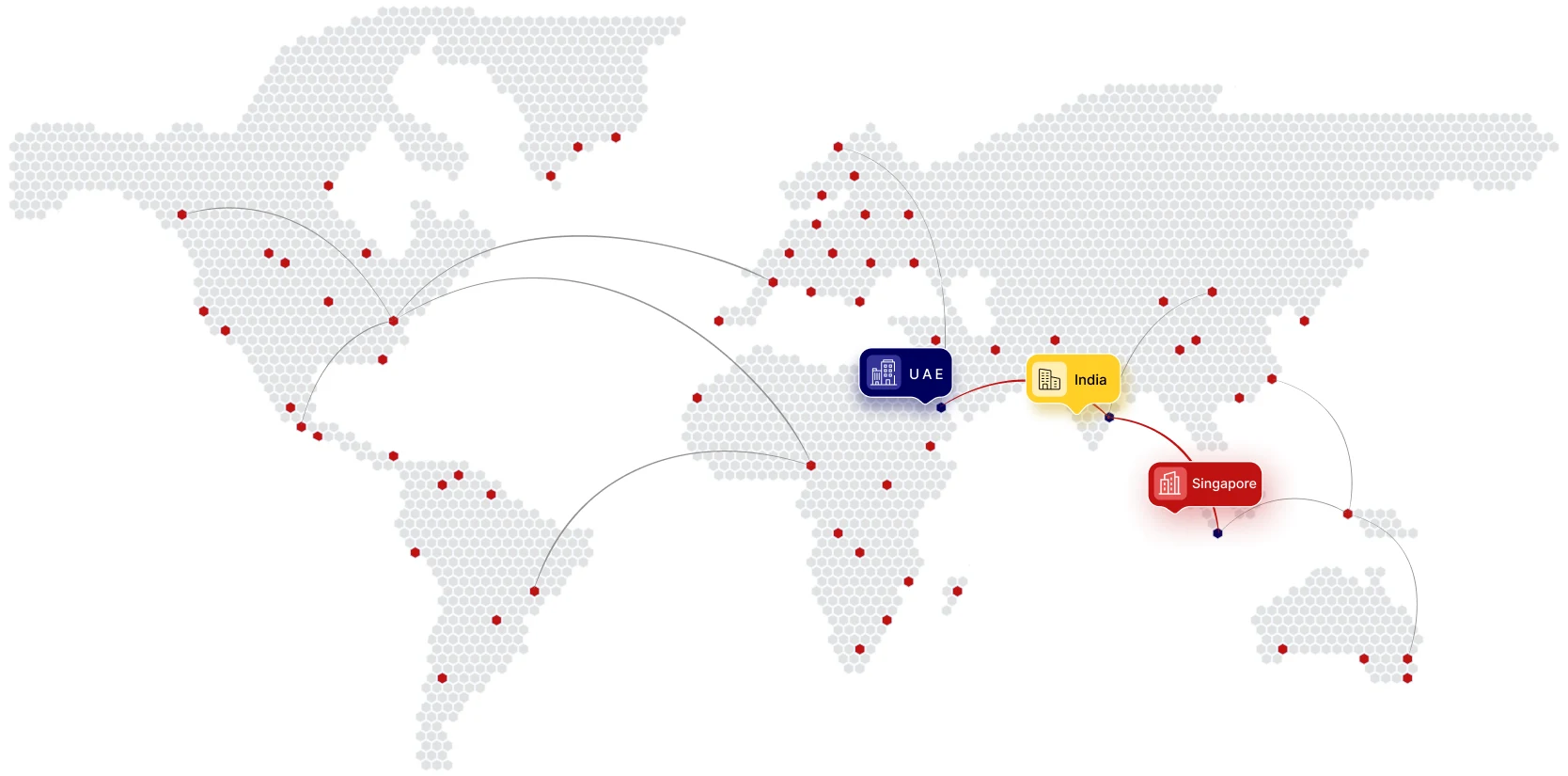
- NEWSLETTER,U.A.E
- August 14, 2023
Legislation and Regulators
The relevant legislation for merger control in the UAE is Federal Law No. 4 of 2012, known as the Competition Law, along with its implementing regulations under Cabinet Resolution No. 37 of 2014. Responsibility for reviewing mergers and acquisitions lies with the Competition Department of the Ministry of Economy.
The Competition Law is still in its early stages, having come into force in 2013. While it is modelled after EU competition law, there remain some gaps that are likely to be clarified through future cabinet resolutions. At present, there is limited precedent on how the law will be interpreted and applied.
Scope of the Legislation
The Competition Law requires parties to notify the authorities of any transaction that results in direct or indirect control of one entity over another, where the merged entity would hold a market share of at least 40%.
Unlike some jurisdictions, the UAE regime does not provide for voluntary notification – if the thresholds are met, notification is mandatory. The law applies to both full and partial acquisitions of interests, though the definition of “control” is not precisely specified.
The notification requirement extends to joint ventures and to transactions taking place abroad that may affect competition in the UAE markets. However, certain sectors like financial services, pharmaceuticals and transport are currently excluded from the scope of the Competition Law.
Assessment Criteria
The Competition Law sets out two main criteria for determining whether a proposed M&A transaction requires approval:
- The merged entity must have a market share of at least 40% post-transaction.
- The transaction must not adversely impact competition, such as by creating or enhancing a dominant market position.
While the 40% threshold is straightforward, the second substantive test creates some uncertainty. It appears to require a competition assessment even at the initial stage of evaluating whether notification is mandatory. It remains to be seen how this will be applied in practice.
Foreign Investment Considerations
Foreign-to-foreign deals must still be notified if the merged entity has UAE operations or sales exceeding the 40% local market share threshold. Separate approvals from sectoral regulators may also be required for foreign entities operating through local branches.
Regulators can exercise discretion to reject transactions based on public policy or national security factors, separate from competition law.
Strategic Considerations
For companies pursuing M&A opportunities in the UAE, here are some tips:
- Assess at an early stage whether the 40% threshold will be exceeded to determine if notification is required.
- Engage advisors to evaluate if a substantive competition assessment may be warranted even below the thresholds.
- Be mindful of potential shareholding and foreign ownership restrictions in the relevant industry.
- Involve advisors to coordinate regulatory approvals and navigate discretionary powers of government authorities.
- Develop a timeline for the transaction that accounts for mandatory notification and approval periods.
- Be prepared for limited precedents and possible lack of clarity on merger control review processes.
With support from experienced advisors like IMC Group, companies can effectively navigate UAE’s merger control regime. IMC offers comprehensive due diligence services in Dubai to help investors evaluate opportunities, risks and approval requirements for successful M&A execution in the UAE.

- NEWSLETTER,SINGAPORE
- August 14, 2023
The Singapore government has introduced several changes to the country’s immigration and employment regulations that will impact organizations in 2023 and beyond.
A new points-based system will govern employment passes for foreign professionals starting September 2023. Applicants will need to meet salary thresholds and pass an assessment considering qualifications, diversity, skill shortages and other factors.
Meanwhile, enhanced workplace guidelines aim to promote fairness and prevent discrimination. Employers must make employment decisions based solely on job requirements and not pressure staff to join non-work activities.
New anti-discrimination legislation expected in 2024 will prohibit bias based on age, race, disability and other attributes during recruitment and employment. Penalties for non-compliant employers may include fines, corrective orders and compensation to victims.
On the benefits front, paternity and infant care leave will be increased from January 2024. The monthly salary ceiling for employer CPF contributions will also be raised in phases starting September 2023.
These changes warrant a review of hiring practices, workplace policies and benefits management to ensure compliance and minimize legal risks. Tapping external expertise can help organizations successfully adapt to the evolving regulations.
With extensive experience enabling Employment Passes in Singapore, IMC Group is well positioned to advise companies on immigration compliance. Contact IMC today to learn more about aligning your foreign workforce strategies with the new immigration rules.

- NEWSLETTER, GLOBAL
- August 14, 2023
Access Specialised Expertise
One of the biggest advantages of HR outsourcing for small businesses is access to specialised expertise and experience. HR outsourcing providers employ professionals specifically trained in key HR disciplines like recruitment, compensation, payroll processing, performance management, employee relations and more.
This expertise allows small businesses to efficiently handle essential HR tasks that may be challenging for in-house teams lacking specific knowledge. Outsourcing providers stay updated on the latest HR best practices, technologies and compliance requirements – expertise that small business owners often lack the time and resources to develop internally.
Boost Efficiency and Productivity
By delegating HR activities to external teams, small businesses can dedicate more time and resources to core business functions central to their success and growth. Outsourcing administrative and transactional HR tasks like payroll, benefits administration and record keeping eliminates the need to manage these time-consuming activities in-house.
The increased efficiency and productivity benefits allow small business leaders to focus their efforts on key priorities like developing new products and services, enhancing customer experiences and identifying growth opportunities. Their time is freed up to work more strategically.
Access Advanced HR Technologies
Leveraging the advanced technologies utilised by HR outsourcing providers is a key benefit for small businesses seeking to work more efficiently. Outsourcing partners invest in HR software, analytics tools, automated platforms and other innovations designed to streamline essential workforce management processes.
Small firms gain access to technology capabilities that would often be costly and complex to implement alone. Advanced solutions like cloud-based HR platforms, real-time workforce analytics and self-service employee portals help drive productivity, engagement and data-driven decision making.
Control Costs
For budget-conscious small enterprises, outsourcing provides compelling cost reduction advantages. Maintaining extensive in-house HR teams requires substantial investments in personnel, software, tools and related infrastructure. HR outsourcing transfers many of these costs to specialised providers.
Rather than large upfront technology costs, outsourcing allows small businesses to pay only for the specific services and solutions utilised – providing flexibility and optimising cash flow. By converting fixed HR expenses into variable operating costs, small firms gain financial flexibility and efficiency.
Ensure Legal and Regulatory Compliance
Navigating the complex and constantly evolving landscape of employment laws and regulations can be an immense challenge for small HR teams lacking specialised legal and compliance expertise. However, non-compliance exposes small businesses to significant legal risks and penalties.
Outsourcing providers have extensive experience interpreting laws and regulations across functions like payroll, health and safety, discrimination, family leave and more. Their guidance and oversight minimise compliance missteps that small in-house teams may inadvertently make due to lack of expertise – providing crucial risk reduction.
Enhance Scalability
As small businesses grow and evolve, HR outsourcing provides the agility and scalability needed to flexibly adapt. Partners can quickly add or adjust HR services and technology solutions to match changing business needs. This scalability allows small firms to pursue growth and expansion without being limited by internal HR constraints.
Whether a small business needs to rapidly onboard new employees, expand to new locations or implement a new HR initiative, outsourcing provides the scalability required to smoothly support these transitions and growth.
Gain Strategic Insights
Beyond handling administrative HR tasks, outsourcing partners increasingly provide strategic insights to support smarter workforce planning and decision making. Analytics, metrics and HR data help identify opportunities to improve productivity, retention, employee satisfaction and other aspects of workforce management.
These insights allow small business leaders to make more informed, evidence-based decisions about their people strategies and optimise human capital – a key competitive advantage.
The Way Forward

- NEWSLETTER, GLOBAL
- August 14, 2023
For ambitious small and medium enterprises (SMEs), growth comes with its fair share of complexities. As headcounts expand, managing payroll and HR in-house can become an unwieldy burden that drains resources better spent on core business priorities.
Yet many SME leaders hesitate to outsource these functions, fearing loss of control or lacking awareness of the value proposition. Join us as we explore how modern payroll outsourcing solutions have evolved into an indispensable growth strategy for forward-thinking SMEs.
The Old Model vs. Today’s Solutions
Traditionally, payroll outsourcing meant handing off the workload to an external provider and losing visibility into the process. But thanks to cloud computing, today’s solutions offer far greater transparency, control and configuration options.
Rather than installing on-premise software and servers, cloud-based payroll systems allow access from anywhere via intuitive web and mobile interfaces. This gives SMEs real-time visibility into payroll data and flexibility to tailor the system to their needs.
Integration with other business software is seamless, enabling easy data sharing across finance, HR and other functions. The combination of cloud platforms and managed service providers creates a new paradigm for payroll outsourcing.
Saving Time and Money
For growing SMEs, time is a precious resource and cash flow must be optimised. Outsourced payroll solutions deliver compelling advantages here.
Streamlining manual tasks, reducing errors, providing self-service options for employees and automating compliance allow SME leaders and finance teams to focus on higher-value priorities rather than administrative burdens.
The economies of scale leveraged by outsourcing partners keep costs variable and scalable rather than saddling SMEs with expensive legacy systems requiring significant IT investment and maintenance.
These advantages have made outsourced payroll solutions highly cost-effective even for smaller SMEs while generating major efficiency gains.
Access to Expertise
Navigating ever-evolving payroll laws, tax codes and HR regulations poses challenges for in-house SME teams, exposing them to compliance risks. But for outsourcing partners, this is their sole focus.
Their teams have specialised expertise and experience optimising payroll workflows and staying compliant as requirements change. This reduces liability while ensuring accuracy.
Strategic providers also offer guidance on minimising tax exposure, enhancing benefits packages to attract talent and developing competitive compensation strategies. Their insights strengthen SMEs’ human capital management.
Rethinking Control
With the right provider, outsourced payroll enhances rather than minimises SME oversight. Web and mobile access offers real-time visibility into payroll data, processing status and compliance documentation.
Configurable dashboards, self-service reporting and transparency into provider workflows reinforce control while eliminating manual monitoring. And integration with complementary business software centralises data for a holistic view across HR, finance and operations.
The New Solution for Growth
As SMEs evolve from startups to scale-ups, managing payroll in-house ceases to be viable. But modern outsourced solutions flip the script on traditional models to empower fast-growing companies. By partnering with specialists like IMC Group, SMEs can leverage tailored solutions that relieve administrative burdens, provide valuable expertise, drive efficiencies and support the flexibility needed to scale successfully. By leveraging IMC Group’s expertise in maximizing profits through outsourcing for small businesses, SMEs can implement customized outsourcing strategies to enhance productivity and cash flow. This provides the fuel for profitability and strategic growth.

- NEWSLETTER, GLOBAL
- August 14, 2023
In today’s complex and rapidly changing business environment, organizations face an array of governance, risk management and compliance (GRC) challenges that can significantly impact their performance, reputation and sustainability if not adequately addressed. To tackle these challenges, more and more organizations are recognizing the importance of taking an integrated approach to GRC.
What is GRC?
GRC refers to the integrated management of governance, risk and compliance activities within an organization. Governance deals with the organizational structure, policies and processes that ensure effective and ethical leadership, accountability and transparency. Risk management involves identifying, assessing and mitigating risks that may impact the achievement of strategic, operational and compliance objectives. Compliance focuses on adhering to relevant laws, regulations, policies and contractual obligations.
Historically, governance, risk and compliance activities were managed in silos within organizations. However, this fragmented approach has major drawbacks. It can lead to duplicative efforts, gaps in coverage, inefficient resource utilization and lack of visibility into organizational risks. This is where an integrated GRC approach brings immense value.
The Benefits of an Integrated GRC Approach
Adopting an integrated approach to managing GRC activities provides numerous benefits, including the below:
- Enhanced risk management through a centralized view of risks across the organization and improved coordination of risk activities
- Increased efficiency through eliminating redundancies and optimizing the use of resources
- Improved compliance through consistent interpretation and implementation of compliance requirements
- Strengthened governance and ethics by ensuring accountability and transparency across the organization
- Better informed strategic planning and decision making with a holistic view of risks and compliance obligations
- Reduced costs through streamlining of overlapping GRC processes and technology integration
By breaking down silos and taking a coordinated approach to managing governance, risk and compliance activities, organizations can enhance their resiliency, agility and performance.
Key Components of an Effective GRC Program
Implementing an integrated GRC approach requires bringing together various components to create a comprehensive and cohesive program. The key components include the below.
Leadership Commitment
Success requires buy-in and active participation from organizational leaders. Leadership must communicate the importance of GRC and allocate sufficient resources to support its implementation.
Risk Management Framework
A framework for consistently identifying, analyzing and addressing risks across the organization is essential. This includes processes like risk assessments, risk reporting and ongoing monitoring of risk mitigation efforts.
Compliance Management System
A structured approach is needed to monitor regulatory obligations, assess compliance, implement controls and track compliance activities across the organization.
Policies and Controls
Robust policies and internal controls reinforce expectations and govern activities in areas like financial reporting, information security, procurement and business ethics.
Training and Awareness
Ongoing training and awareness building ensures employees understand their GRC responsibilities. This contributes to a culture of accountability and integrity.
Technology Enablement
GRC technologies provide automation, streamline processes like risk assessments and compliance tracking, and enable data analysis to support better decision making.
Reporting and Monitoring
Key performance indicators, risk reports, compliance dashboards and internal audits provide visibility into the effectiveness of the GRC program.
Continuous Improvement
Regular assessments, benchmarking and stakeholder feedback identify opportunities to strengthen and enhance the organization’s GRC activities.
By integrating these components into their strategy and operations, organizations create a robust foundation for managing risk, meeting compliance obligations, and fostering an ethical culture.
Conclusion
A properly designed and implemented integrated GRC program provides numerous benefits, from enhanced risk management to improved compliance and governance. As organizations pursue their objectives in an increasingly disruptive world, an integrated approach to GRC is no longer just a best practice – it is an organizational imperative. With Enterprise Risk Management solutions from IMC Group, organizations can build a GRC program tailored to their unique needs and priorities to fulfil this imperative, while strengthening their posture for long-term success.

- NEWSLETTER,U.A.E
- August 14, 2023
The United Arab Emirates (UAE) has introduced additional conditions for investment funds to qualify for tax exemptions, as part of its implementation of the corporate tax regime that began in 2023. The Cabinet announced these new requirements to provide clarity for funds looking to optimise under the new tax system. According to the UAE Ministry of Finance (MoF), the diversity of ownership criteria for funds, excluding Real Estate Investment Trusts (REITs), will be non-binding for the first two financial years after establishment. This provision allows new funds ample time to diversify their ownership structures to comply with the requirements.
For investment funds excluding REITs, the key highlights of the new corporate tax exemption conditions are as follows: The fund should primarily be engaged in investment activities, with non-core revenue not exceeding 5% of total annual revenue. No single investor and its related parties can hold over 30% or 50% ownership interest, depending on the total number of investors. The fund must be overseen by an investment manager with at least three investment professionals, and day-to-day management cannot be controlled by investors.
For REITs, the new conditions include a minimum real estate asset value (excluding land) of AED 100 million. At least 20% of the share capital must be publicly listed or wholly owned by two or more institutional investors. The trust must maintain an average annual real estate asset percentage of at least 70%.
The new regulations aim to ensure that funds benefiting from the tax exemption meet the UAE’s policy objectives around investment activities, investor diversity, governance, and fund management. The Ministry of Finance explains that the rules provide simplicity and flexibility for funds to optimise under the new regime while maintaining the UAE’s position as a leading investment destination.
Fund managers and investors are urged to review their current fund structures and ownership patterns to identify any potential non-compliance with the updated exemption conditions. Key considerations include assessing investor diversification against the defined threshold limits, evaluating the nature and mix of activities to meet core investment business tests, and for REITs, confirming that real estate asset values and share listings meet requirements. Consideration should also be given to the review of fund governance models, including manager credentials, and developing a roadmap to meet these rules within the allowed timeframes. By aligning with these exemption conditions, funds can minimise their corporate tax liability and uphold their value proposition for investors.
Given the novelty and untested nature of these regulations, a professional advisory is crucial for funds seeking to optimise their tax positions. IMC Group, a corporate tax advisory in Dubai, can help funds and investors interpret the new rules, identify areas for alignment, and develop clear strategies to meet compliance obligations while benefiting from exemptions. If you need more information and guidance on implementing robust corporate tax frameworks under the UAE’s new regime, contact IMC today.

- Article, Global
- August 1, 2023
As we enter 2023, HR professionals continue to navigate a rapidly evolving landscape. The post-pandemic world, coupled with the rise of automation and the growing emphasis on employee well-being, is driving significant changes in the recruitment domain. So, how well is your HR department poised to tackle these new challenges?
Besides navigating the global talent pool amidst the remote work environment, organizations need to address complexities in international payroll management and global relocations. HR professionals need to stay abreast with the latest trends to spearhead their organizations.
In this article, we’ll explore the key trends that will shape HR strategies in 2023.
The Evolving Nature of Work: Embracing Remote Work and Flexibility
Amidst the pandemic, the hybrid and remote work models used to be an option. However, forward-thinking organizations are embracing these operational models as the preferred structure. With the remote hiring model, HR professionals can foray into global pools of talents beyond their demographics.
Organizations have realized the strategic benefits of these flexible work models. This includes global hiring opportunities and reduced carbon footprints. The traditional five-day office week has lost its appeal in the current work environment.
Consequently, navigating the global talent pool presents both challenges and rewards. HR professionals are prioritizing flexibility in terms of work location, hours, schedules, and even operational methods. Now, the focus lies not on where the work is done, but the actual productivity employees bring to the table.
Embracing Diversity for Success: Nurturing an Inclusive Workplace
In 2023, HR professionals highly emphasize creating an inclusive culture. This prioritizes Diversity, Equity, and Inclusion (DEI) in their workforce. It’s common to find global organizations investing in initiatives that promote diverse hiring practices. For instance, many organizations are expanding their recruitment efforts to establish ERGs (Employee Resource Groups).
The opportunity to hire employees from any part of the world expands your talent pool. With this cultural shift, global organizations are working with a new generation of workers. This workforce perceives the future of work beyond the introduction of new operational conditions. They also prioritize the way businesses treat workers, communicate with them, and invest in their well-being. Businesses are allocating larger budgets for cultural projects that foster inclusivity. Organizations are also embracing advanced solutions for managing international payroll complexities with a diverse workforce.
Emphasizing Workforce Wellness as a Key Priority
The past year has witnessed a surge in employee burnout and a decline in employee retention rates. In 2022, “quiet quitting” used to be the buzzword. No wonder, why successful organizations prioritize employee well-being in 2023.
For employees, getting their needs and expectations addressed continues to be a priority. Therefore, HR initiatives that were previously overlooked are now taking center stage. Therefore, new HR standards are likely to be introduced in different industries in 2023. These include:
1. Fulfilling Employee Expectations
HR professionals are focussing on the implementation of pulse surveys to manage employee expectations effectively. These surveys will provide employees with an opportunity to express their thoughts on relevant aspects. This can range from employee benefits to internal organizational matters.
2. Additional Educational Resources
Organizations are allocating additional resources to educational initiatives for employees to foster continuous learning and development. This goes beyond educating the employees on company policies and tools. The approach is more holistic, encompassing comprehensive financial training. It should include topics like equity, wellness, mindfulness coaching, and other initiatives. Ultimately, these HR trends will contribute to a more engaged and informed workforce.
3. Balancing Work and Life
Striking a healthy work-life balance and ensuring sustainable work practices are imperative to HR processes. Thus, recruiters need to focus on creating sustainable work environments by introducing change management practices. They also need to train business leaders on healthier approaches. With this approach, employees would have additional resources to effectively manage stress and pressure. Organizations can, therefore, ensure the long-term sustainability and success of their workforce.
The Must-Have Duo: Automation and Data
Digital transformation has emerged as a prominent and enduring trend within the realm of HR. While certain individuals are still grappling with its implementation, others have successfully forged partnerships with AI and seamlessly integrated robots with endearing monikers into their workforce. To effectively adapt to this paradigm shift, what measures can you undertake to remain abreast of these changes? The foundation of people analytics rests upon the pivotal pillars of automation and data analysis. By embracing these pillars, organizations can alleviate the burden of manual, time-consuming tasks that deplete valuable time and resources. It is important to note that the objective is not to replace human involvement, but rather to enhance it. Therefore, it is imperative for every HR leader to leverage these tools to drive improvement.
Data analytics empowers HR professionals to gain deeper insights into their metrics, enabling them to make more informed and strategic decisions. This data-driven approach facilitates the implementation of crucial changes in areas such as employee engagement. In fact, all Chief Human Resources Officers (CHROs) should heavily rely on the data collected from their workforce when making critical decisions regarding company culture, employee retention, and addressing talent shortages.
Automation plays a vital role in people operations as it streamlines administrative tasks, reducing time and effort while improving accuracy and efficiency. By relieving HR teams from mundane tasks that do not contribute to employee development, automation enables them to focus on more impactful initiatives. The effective implementation of HR technology can be the key factor in reducing burnout and enhancing overall employee happiness, surpassing the benefits of traditional courses or webinars.
Prioritizing Skills and Revolutionizing the Hiring Process
In 2023, skill-based hiring takes precedence as organizations recover from widespread layoffs. Traditional parameters of success such as certificates and degrees are no longer the only criteria for HR professionals to evaluate candidates. Rather, organizations are prioritizing agility and adaptability, prioritizing the skills of candidates. Collaboration, communication, and problem-solving are some of the highly-sought skills, along with technical experience.
Besides, HR professionals are hiring employees with versatile skills to meet the evolving demands of the market. Companies are also designing clear and achievable career paths to attract and retain top talent. These include opportunities for horizontal mobility that would foster better growth and satisfaction for employees.
Navigating International Relocation and Global Talent Pool
In an interconnected operational paradigm, HR teams are expanding their talent acquisition strategies beyond borders. With international relocation and global mobility services in high demand, successful players are forging collaborations with efficient partners. Right from managing payroll for international employees, maintaining compliance with local regulations, and ensuring a seamless employee transition across borders, HR professionals need to prioritize several tasks. Therefore, partnering with Employer of Record (EOR) or Professional Employer Organization (PEO) services can provide valuable support in managing an international workforce.
IMC Group continues to be one of the leading partners offering EOR & PEO services. Collaborating with the right Global Expansion partner can help you take a progressive path to success amidst the competitive business environment.

- NEWSLETTER,SINGAPORE
- July 12, 2023
The UK and Singapore have committed to jointly advancing government use of data and emerging technologies. Two new Memorandums of Understanding (MoUs) were signed this week during UK Deputy Prime Minister Oliver Dowden’s visit to Singapore.
The agreements between the UK’s Department for Science, Innovation and Technology and Singapore’s Ministry of Communications and Information and Smart Nation and Digital Government Office aim to deepen research and regulatory cooperation. They build on the UK-Singapore Digital Economy Agreement and Free Trade Agreement, supporting the £11.4 billion in annual services trade between the nations.
Deputy Prime Minister Dowden said: “Emerging technologies like AI present opportunities and challenges for all countries. By cooperating on research, regulation and government use, we can deliver better public services. The UK and Singapore are tech leaders, and these agreements will strengthen that position and boost trade and investment.”
Singapore Minister for Communications and Information Josephine Teo commented: “These MoUs build on our recent deals in digital trade, identities and cybersecurity. The speed and rigor of our collaboration shows our strategic alignment on the digital economy, AI, future communications and data.”
The MoUs will enable “tangible benefits for businesses and people,” she said.
UK Technology Secretary Chloe Smith added: “Agreements like these drive the PM’s vision of the UK as a leading tech nation, especially in fast-evolving areas like AI. As advanced tech economies, the UK and Singapore will benefit greatly from close cooperation on new technologies and data use.”
The Emerging Technologies MoU commits to
- Sharing experiences implementing new infrastructure like 5G to improve connectivity.
- Promoting AI business partnerships and replicating ‘trustworthy’ AI.
- Aligning AI technical standards.
- NHS and Singapore research on using AI to enhance healthcare.
The Data Cooperation MoU commits to:
- Increasing digital trade and sharing data use best practices to improve government efficiency.
- Establishing an intergovernmental dialogue on data regulation, protection and transfer.
- Sharing research on using data to deliver better public services and growth.
- Developing standards for publishing anonymised government data to enable global cooperation.
- Sharing best practices for government and public-private data management.
Together, the MoUs position the UK and Singapore as leaders in data-driven tech and governance. With rapid digitalisation and an exponential rise in cross-border data flows, establishing models of open yet secure data access and use is crucial.
These agreements indicate a shared commitment to navigating the frontiers of emerging tech and establishing a governance blueprint for the digital age. By openly exchanging lessons learned and forging a joint vision of responsible data and AI advancement, the UK and Singapore can set standards for optimising the benefits of technology in government and business.
At this watershed moment, data and AI partnerships between advanced and trusted nations are pivotal. The UK-Singapore partnership serves as a model for ethical digital cooperation and governance on a global scale.
To learn more about data, AI, technology partnerships, and steps to incorporate a company in Singapore, contact IMC Group. As leaders in forging and facilitating multinational technology collaborations, IMC is well-positioned to provide strategic counsel and support in identifying, negotiating, and implementing impactful global data and AI alliances.

- NEWSLETTER, GLOBAL
- July 12, 2023
Transaction advisory is essential for major business deals, as evidenced by both triumphs and disasters. Advisors help guide strategic decisions and avoid costly mistakes through services like valuation, due diligence and M&A counsel.
Consider Disney acquiring Pixar in 2006 for $7.4 billion. Pixar made blockbusters like Toy Story and became Disney’s most successful film studio. Disney likely relied on advisors to value Pixar, conduct due diligence and negotiate the deal. The result was a massive success, demonstrating the value of expert transaction advisory.
Conversely, Time Warner acquiring AOL in 2000 for $182 billion failed spectacularly. Within a year, the combined company lost $99 billion in value as the tech bubble burst. Lack of advisors contributed to overpaying and botching the risky, ill-conceived deal.
In 2005, Procter & Gamble acquired Gillette for $57 billion, gaining brands like Braun, Duracell and Gillette. Valued at nearly 2x Gillette’s market cap, the deal was risky but rewarding long-term. Advisors probably assessed the strategic rationale, growth opportunities and cultural fit to convince P&G to go ahead. Fifteen years on, it seems an inspired move demonstrating advisory’s long view.
Compare this to Kraft Heinz buying Unilever in 2017 for $143 billion, unsuccessfully attempting a hostile takeover. If accomplished, it may have burdened Kraft Heinz with massive debt, as Unilever rejected the offer. However, with extensive due diligence advisors could have objectively evaluated the deal and avoided this failure.
In 2000, eBay bought PayPal for $1.5 billion, gaining a payments arm and fuelling its growth into a $36 billion company. EBay likely relied on advisors to spot PayPal’s potential, negotiate the deal and develop an expansion strategy. This showcase success proves great advisory adds exponential value.
Finally, consider WeWork’s failed 2019 IPO that lost SoftBank billions and ousted CEO Adam Neumann. Had WeWork employed advisors, they may have assessed the company as overvalued, lacking viability for public markets. The risky deal may have been restructured or avoided, sparing stakeholders significant losses.
The examples underscore the benefits of Transaction Advisory Services and the risks of not having them. For significant deals, expert counsel from firms like IMC Group offers essential long-term perspectives, objective assessments, and Due Diligence Services that can mean the difference between success and failure. By balancing opportunities and viability, advisors guide businesses to structurally sound, value-generating transactions.

- NEWSLETTER, GLOBAL
- July 12, 2023
Cybersecurity and compliance are two of the biggest challenges facing today’s organisations. There are several reasons for this.
- Cybersecurity threats and regulations are constantly evolving. Cybercriminals are continuously developing new methods to attack businesses, while regulators regularly modify existing rules and introduce new ones.
- Compliance requires a lot of repetitive, manual work to gather evidence and fill in forms. There is also an overwhelming amount of information to monitor and analyse, yet a shortage of skilled professionals to do so.
- Most large organisations work with thousands of suppliers, making vendor risk management an enormous task.
Although governance, risk and compliance (GRC) tools have been available for some time, many are cumbersome and outdated. Organisations need an automated, unified approach to risk management that improves compliance and boosts cybersecurity.
If your organisation is looking to replace traditional GRC tools, consider the following attributes:
Everything in one place
If risk, vendor, contract and IT asset data are stored in separate systems, it’s difficult to analyse and report on. An integrated GRC platform provides a ‘single source of truth’ by automatically updating data from various sources.
Support for Automation
Essential tasks like penetration testing, risk monitoring, vendor assessments and security event analysis should be automated. Manual processes are inefficient, error-prone and unable to keep up with the pace of business.
Available Integrations
Integrations with systems like single sign-on, SIEM, SOAR and business software enable the automatic collection and analysis of compliance evidence. Without them, demonstrating adherence to standards is challenging.
Simple to Use
Exporting data in an easy-to-understand format is key for demonstrating progress to auditors, management and employees. Templates and intuitive interfaces also help stakeholders without technical backgrounds gain insights.
Streamlined Data Input
While risk input requires human judgement and can’t be fully automated, the process should be as simple as possible. Time spent manually entering risks into the GRC platform reduces that available for strategic work.
Augmented with AI
Modern GRC tools apply AI to detect anomalies in data, identify cyber threats and streamline repetitive tasks like report generation. This reduces the burden on cybersecurity and compliance teams while improving effectiveness.
100% security isn’t possible, so organisations must accept and manage risk. An automated, integrated GRC platform with AI helps demonstrate your value and instils confidence in stakeholders that the organisation is compliant and secure.
To find out more about modern governance, risk and compliance solutions, contact IMC Group. IMC Group’s GRC platform integrates all your systems into a central solution augmented by AI to provide a new level of risk visibility and control. IMC Group also offers cutting-edge Enterprise Risk Management (ERM) solutions to help organizations effectively identify, assess, and manage risks. By incorporating ERM into their suite of services, IMC Group ensures that companies can proactively address potential threats, maintain regulatory compliance, and make informed decisions. With these Enterprise Risk Management solutions, businesses can achieve a comprehensive approach to GRC and drive sustainable growth in today’s dynamic and uncertain environment.
A Member Firm of Andersen Global
- 175+ Countries
- 525+ Locations
- 17,500+ Professionals
- 2350+ Global Partners

















